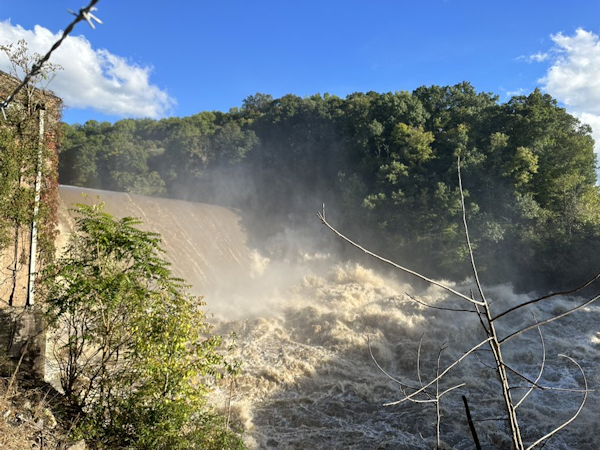SEJournal Online is the digital news magazine of the Society of Environmental Journalists. Learn more about SEJournal Online, including submission, subscription and advertising information.
 |
 |
| The Nolichucky Dam in Greene County, Tennessee, in the wake of Hurricane Helene on Sept. 27, when the Tennessee Valley Authority issued a warning it was approaching its threshold to withstand excessive floodwater. A day later, the TVA issued a warning of an imminent breach before waters began to fall. Photo: Tennessee Valley Authority via @TVAnews on X. |
TipSheet: Will Your Local Dam Turn Deadly in the Next Big Storm?
By Joseph A. Davis
In 2016, at least 17 dams in North Carolina failed following the rains from Hurricane Matthew. In that case, no one died.
But with the recent deadly flooding from Hurricane Helene, not to mention all the other storms and flooding we are seeing these days, it’s a good time for environmental journalists to ask whether their own nearby dams are safe.
Climate change and other forces
are causing downpours and floods.
And resulting dam failures can
harm people and damage property.
Spoiler alert: They aren’t, at least not all of them. Climate change and other forces (like the El Niño cycle) are causing downpours and floods all over the globe in recent years. And resulting dam failures can harm people and damage property.
It’s not a new story, just an important one. Flooding from dam failures more often causes property loss. But go back to the Johnstown Flood, caused by a dam failure in 1889, which killed more than 2,200 people. The 1928 St. Francis Dam failure in California killed over 450.
 |
The backstory
Most of the 90,000 dams in the National Inventory of Dams are privately owned and thus regulated (if at all) by state dam safety agencies. The bigger dams operated by federal and state agencies are somewhat better regulated — though some of these are neglected and unsafe as well.
The Buffalo Creek disaster of 1972 (125 killed) brought passage of legislation establishing the National Dam Safety Program under the Federal Emergency Management Agency.
Unfortunately, the program has not done very much over the years. Funding has been very low, with most of it going to grants to states. A bit more funding became available under the Biden administration’s infrastructure laws.
Simply getting information
about dam safety has been
difficult in recent decades.
Simply getting information about dam safety has been difficult in recent decades — although the Army Corps of Engineers, which operates the National Inventory of Dams, has improved disclosure somewhat in recent years.
Many of the dams that fail in big rain/flood events are small, neglected, with “owners” who may have vanished years ago.
Story ideas
- Use the inventory to find risky dams in your audience area. There may be hundreds, or even thousands.
- Look in your area of interest for “high-hazard” dams (those where failure could cause loss of life) or “significant-hazard” dams (whose failure could damage property). Figure out what the hazard is: typically, it’s human settlement downstream.
- Ask whether your high-hazard dams have an “emergency action plan.” If so, ask for a copy (you may not always get it). The plan should say who is responsible for public notice and evacuation if failure is imminent. If there is no plan, why not?
- Get the latest inspection report on your high- and significant-hazard dams. Did you have any trouble getting it? Why? Is the dam in safe condition? Is needed action being taken to make it safe?
- Is the dam currently serving any useful purpose? For example, some dams once meant for hydropower no longer generate electricity. Does the dam present a flooding threat (some dams were meant for flood control)?
- Is the dam a candidate for removal? Does it block the migration of migratory fish like salmon, trout or shad? Who must pay, and who must approve, for the dam to be removed?
Reporting resources
- National Inventory of Dams: This database, managed by the Army Corps of Engineers, lists roughly 90,000 of the most important dams in the United States.
- State Engineers: Many states have an official engineer who is in charge of dam safety. Look yours up.
- Local Waterkeepers: A network of several hundred local organizations dedicated to conservation of rivers and other water bodies. Find yours here.
- Association of State Floodplain Managers: An organization of professionals in floodplain management, flood hazard mitigation and flood preparedness.
- National Flood Insurance Program: Organized under FEMA, the program has a decent, if sometimes outdated, set of flood plain maps.
- Association of State Dam Safety Officials: A professional group of state officials working for dam safety.
- American Rivers: A membership-based group that advocates for river protection. It has local chapters focused on particular rivers and keeps a database of dams that have been removed.
[Editor’s Note: For more dam-related stories, Reporter’s Toolbox explores a data project on the nation’s disintegrating dams, updates on the National Inventory of Dams and finding stories with the database. We have TipSheets on hydro relicensing, dam removal and the crisis for dams. WatchDog Opinion examines the dangers of dam secrecy and the information legacy of 9/11. There’s more, too, on covering inland flooding, flood risk disclosure, extreme rainfall and community resiliency. Plus, track headlines on dam reporting in the news via EJToday here.]
Joseph A. Davis is a freelance writer/editor in Washington, D.C. who has been writing about the environment since 1976. He writes SEJournal Online's TipSheet, Reporter's Toolbox and Issue Backgrounder, and curates SEJ's weekday news headlines service EJToday and @EJTodayNews. Davis also directs SEJ's Freedom of Information Project and writes the WatchDog opinion column.
* From the weekly news magazine SEJournal Online, Vol. 9, No. 36. Content from each new issue of SEJournal Online is available to the public via the SEJournal Online main page. Subscribe to the e-newsletter here. And see past issues of the SEJournal archived here.













 Advertisement
Advertisement 



